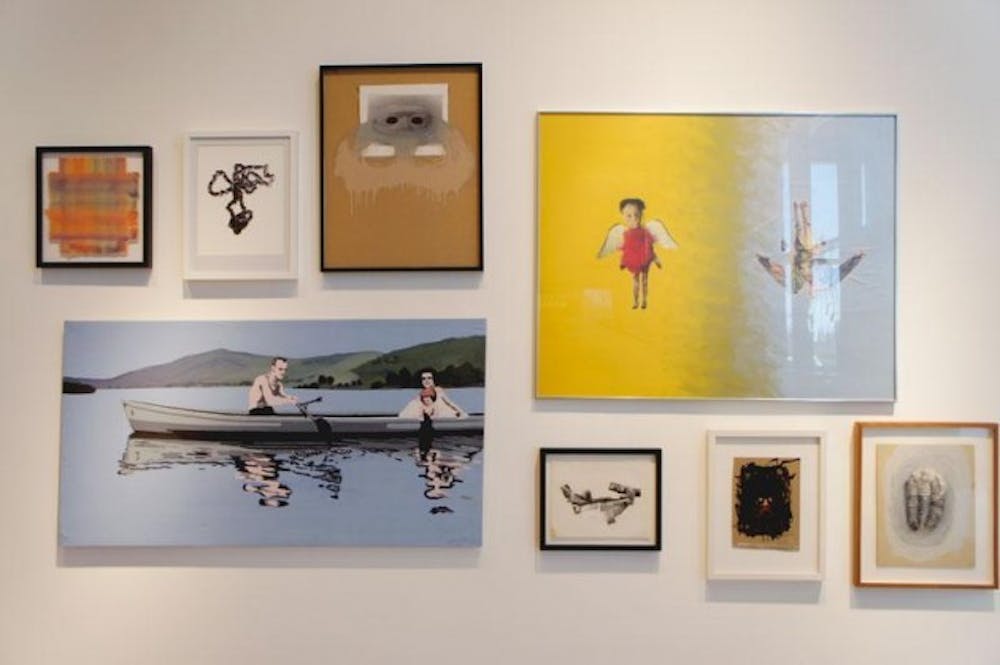Finger paintingis usually reserved for toddlers, but Charles Clough proved otherwise.
Clough, the artist whose work is on display in the first floor at the CFA art gallery, has perfected the art of finger painting. The exhibit, entitled Charles Clough: The Way to Clufffalo, highlights Clough's artistic journey from the early 1970s to the present.
His finger painting works were the highlight of the exhibit. Their bright colors and intricate patterns are a feast for the eyes, injecting palpable energy into the stark white walls of the gallery.
UB Art Gallery Curator Sandra Q. Firmin, who has been curating the UB galleries for nine years, chose the exhibit because she felt Clough and his work uniquely represented the identity of the Buffalo area and the legacy of the Buffalo avant-garde scene.
"Charlie Clough was an artist who I was really intrigued by," Firmin said. "I went out to Los Angeles where he lived and I saw the early works and they fascinated me. Also, Charlie is a part of [the] Hallwalls [legacy]. Hallwalls [Contemporary Arts Center] was one of the first alternative art spaces in Buffalo."
Clough's earlier works first drew Firmin to the artist. The pieces embody Clough's artistic term "PEPFOG," an acronym for the "photographic epic of a painter as a film or a ghost," which refers to the way people have increasingly related to art through a camera lens. The prominences of the eye, and the strong element of voyeurism in his early pieces, showcase how the artist acts as a translator between art and spectator.
His early work features magazine cutouts of eyes as well as blown-up pictures of Clough's own eye. The eyes are often distorted in some way, whether by simply being flipped upside down or by being obscured by swirls of brightly colored paint. The most provocative aspect of these pieces show Clough's personal pictures painted over his characteristic finger-paint style.
Clough's later work does not translate the notion of "PEPFOG" as literally with the eye, but it certainly does play with perception. The finger painting that was not fully developed in his work in the early 1970s comes full force as his work progresses.
The finger painting technique Clough uses is no kindergartener's task. It's an intricate method that must be exercised with meticulous precision to prevent the muddling of all the colors into brown. To create his work, Clough uses giant finger painting tools that are on display in the gallery. Firmin was able to use these tools and experience the difficulty of the technique firsthand through one of Clough's group painting workshops.
"I realized what kind of a fascinating artist he is and also how difficult what he does is," Firmin said. "His strategy, and the way he paints, is actually really difficult. If you go too far it turns into mud. You get a nice effect, and you become tentative. You don't want to ruin it."
The "Big Finger" painting series show how complex the paintings are and how various the effects could be. "Delelorum," enamel on masonite, is a work in the series that highlights intricate dragging patterns. Clough manages to create negative space that isn't at all negative by using a diverse range of color in shade and tone; the colors work together to confuse the division between negative and occupied space. The thick strokes combined with thin dragging lines also construct this altered perception, and it becomes easy to get lost in the work.
Another standout piece was "Arabesque," enamel on linen. Clough blended the yellowy colors against darker shades, creating a veiny effect when viewed up close.
The danger of this type of abstract expressionism is the immediate dismissal of it as amateurish, simply because it looks easy to do. Charles Clough: The Way to Clufffalo, however, proves that such art requires a detailed, difficult process that is rewarding for all parties involved.
"[Clough was] rewarding to write about [because of] a couple of things," Firmin said. "His love of abundance. He is like a machine, and he just produces and produces - his love of color, his joy. The joy he takes in painting and his desire to communicate joy to other people."
Charles Clough: The Way to Clufffalo will be on display in the UB Art Gallery until May 19.
Email: arts@ubspectum.com





